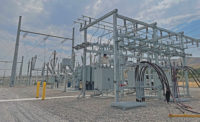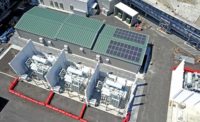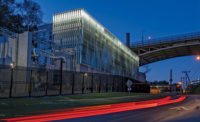Downtown GIS Substation
Denver
Best Project
Owner: Xcel Energy
Lead Design Firm: Burns & McDonnell
General Contractor: W.E. O’Neil
Structural/Civil/MEP Engineer: Burns & McDonnell
Architect: Humphries Poli Architects
Foundation/Substation Construction Contractor: PAR Electrical Contractors Inc.
Precast Concrete: Stresscon Corp.
Denver is growing rapidly, which means that Xcel Energy needed to increase electrical capacity for the downtown core. But vacant land there is scarce. So, instead of looking for a larger site for the downtown substation, the utility decided to make technological changes at the present location. Helped by 3D modeling, the contractor built the new substation within the tight confines of the existing property.
The solution was to transform, incrementally, the substation’s 115-kV, air-insulated straight bus into a new 115-kV, gas-insulated substation (GIS) configured ring bus. That would increase the system’s reliability and create space for equipment to serve Denver’s future electrical needs.
The urban-core jobsite presented numerous challenges. In the heavily restricted space, onsite construction parking and laydown areas simply weren’t available. It would have been costly to close or obstruct busy arterial streets and sidewalks adjacent to the property. Holidays and special events prohibited street closures, adding to the scheduling and construction issues.
The space restrictions continued below grade. The existing electrical equipment enclosure (EEE) obstructed access to control and power circuits. To get around the problem, the contractor installed four 20-in.-dia pipe casings beneath the EEE foundation using the jack-and-bore method to avoid vibrations that could affect working electrical equipment.
The use of case boring and helical piles expedited the installation of GIS equipment within the site’s small footprint. In particular, the helical piles, in lieu of drilled-pier foundations, significantly reduced construction time.
The contractor’s safety program included pretask analysis, activity-hazard analysis and regular health and safety audits of the site.
With the GIS and enclosure installed, Xcel Energy can move forward with the final phases of transitioning the other 115-kV elements into the GIS. The substation is expected to improve reliability on the 115-kV transmission system. It also will enable future installation of equipment for improvement of the medium-voltage distribution network in downtown Denver.
Related Article: ENR Mountain States Best Projects 2018: A Healthy Mix of Public and Private Projects Garner This Year's Top Awards






Post a comment to this article
Report Abusive Comment